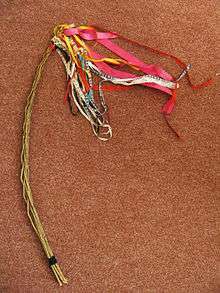Traditional Easter games and customs
There are a large number of traditional Easter games and customs in the Christian world. Many of these games incorporate Easter eggs. Although adopted into the Christian tradition of Easter, these games are probably based in ancient fertility cults[1] (this is a classic example of syncretism). Of these the most well known, widespread and popular until the modern times are the egg rolling, egg hunt, egg tapping, and egg dance. Their rules may vary in different cultures and localities. At the same time, there exist less known peculiar customs. Nowadays child entertainers and kindergartens invent various new Easter games, often adapting well-known games to Easter topics, such as word puzzles involving Easter-related words. These are not discussed in this article.
Egg games
- The rules of egg rolling may vary significantly, with the basic idea being an egg race. The eggs are either rolled down a steep hill or pushed across a lawn with sticks.
- Egg hunt is a kind of treasure hunt game: children have to collect as many hidden eggs as possible.
- Egg tapping is a contest for the hardest egg: the contestants tap each other's eggs with egg tips and optionally with other parts: "butts" or sides.
- Egg dance requires dancing among eggs while keeping them undamaged. In some traditions the egg dancer may be blindfolded.
- Venetia Newall describes egg eating competitions in Western Germany and among German emigrants to Pennsylvania, United States.[2]
- In many parts of Germany a popular Easter pastime is egg throwing. In this "game" there are no winners or losers, nor any apparent aim. Participants throw a painted and decorated hard boiled egg as far as they can across the fields. This is repeated until eventually the egg bursts apart, an event that takes a sometimes surprising number of throws. In other versions it is a competitive event when pairs throw a raw egg to each other while moving further and further apart.
Others
- Strutt and Hone in their 1867 book The Sports and Pastimes of the People of England describe an Easter tradition from the Isles of Scilly called goose dancing. For goose dancing the maidens dress up as young men and vice versa. In this disguise they visit neighbors for dancing and making joke stories.[3]

- In some Central European countries (Poland, Czech Republic, Slovakia, Hungary) there is a tradition of sprinkling girls and women with water and spanking them with "Easter switches".[4] The switches are made of willow rods decorated with color ribbons. The Polish tradition is called "Śmigus-Dyngus", and is a tradition, that goes back to the Middle Ages. In the Czech Republic, such a switch is called pomlázka meaning "rejuvenator", implying that a female struck by a pomlázka will become younger and prettier.
References
- ↑ Venetia Newall (1971) An Egg at Easter: A Folklore Study, p. 321
- ↑ Venetia Newall, p. 332
- ↑ Joseph Strutt, William Hone (1867) "The Sports and Pastimes of the People of England From the Earliest Period; Including the Rural and Domestic Recreations, May Games, Mummeries, Pageants, Processions and Pompous Spectacles", p. 349
- ↑ Venetia Newall, p. 315